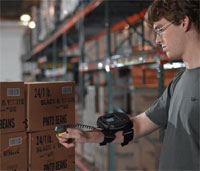From SCDigest's On-Target E-Magazine
- Feb. 20, 2013 -
Logistics News: What are the Latest Trends in Data Collection and Wireless in Distribution?
Hands-Free (Voice and Wearables) Continue to Gain Share, Motorola's Wheeler Says; Tablet Interest High for Some DC Applications
SCDigest Editorial Staff
This week, SCDigest editor Dan Gilmore gave a presentation at the Motorola Solutions Channel Partner Expo, an event for resellers of Motorola equipment and systems.
At the event in Las Vegas, Gilmore had the chance to sit down with Mark Wheeler, a director of industry solutions for Motorola focused on the warehouse and distribution sector, to discuss his perspectives on user trends for wireless data collection devices.
SCDigest Says: |
 |
| All you really have to do is follow say a worker doing replenishment and watch him or her do their job putting down and picking up a traditional handheld terminal or trying to hold both the terminal and the carton at once, and the opportunities for hands-free become very clear. |
|
What Do You Say?
|
|
|
|
Gilmore: I am very intrigued and positive on the "wearable" wireless devices, which I think can offer some excellent productivity gains. How is user adoption going?
Wheeler: All told very good, certainly growing at faster than the overall wireless market. We have a huge number of devices out there, so it sets a high bar for growth.
It's interesting, some companies have a sort of cultural thing going on where they for some reason don't think they want their associates to wear a device, even though they are very light weight and ergonomic when say worn on the forearm. That can sometimes be a barrier to adoption.
Gilmore: That doesn't make any sense to me today - I have been in 4 or 5 DCs using wearables, and the workers there seem to love them. Has anyone ever deployed wearables and later pulled them out because of operator ergonomic issues?
Wheeler: No, as you said, users love them once they have them. It makes their jobs easier, and they don't have to carry around say a traditional handheld. If it is an issue with the idea, it comes from management not associates.
Gilmore: What kinds of companies are adopting wearables?
Wheeler: A wide variety of companies. We see a lot of interest in parcel sortation, where wearables have a natural fit [SCDigest note: UPS was an early and continuing customer].
3PLs also love wearables due to the flexibility they can provide. And the third area is really in any company that wants to use voice, which our wearables can support, but need to also capture other data via a bar code scan, such as a serial number.
Gilmore: That last example is the sort of so-called "multi-modal" type of device that supports different data collection types. Is that need really starting to crystalize in the market?
 Wheeler: Multi-modal thinking is gaining traction though still early in its development. But in addition to the existing needs and flexibility multi-modal devices provide companies, new requirements like the emerging food safety rules that should soon be released are likely to increase the attractiveness of multi-modal for a new group of companies. Wheeler: Multi-modal thinking is gaining traction though still early in its development. But in addition to the existing needs and flexibility multi-modal devices provide companies, new requirements like the emerging food safety rules that should soon be released are likely to increase the attractiveness of multi-modal for a new group of companies.
Gilmore: Whether it is wearables or voice or a combination, the common denominator is "hands free." For many of DC tasks, picking and replenishment especially, the case for the advantages of hands-free seems simply overwhelming to me - often 20-30% in productivity gains. It should become a best practice, in my opinion.
Wheeler: All you really have to do is follow say a worker doing replenishment and watch him or her do their job putting down and picking up a traditional handheld terminal or trying to hold both the terminal and the carton at once, and the opportunities for hands-free become very clear.
[Wheeler also shared the name of a large autoparts retailer and a few ecommerce retailers that had recently adopted wearable devices, but the names cannot yet be released.]
(Distribution/Materials Handling Story Continues Below
)
|